When you see the word “script,” you probably think of a movie script or a television play, which provides performers with a set of actions or dialogues to follow. You might be wondering why I’m connecting this to Bash scripting.
Well, Only because Bash scripts work just the same as a movie script the computer is instructed what to do, so we are controlling the actions of the Bash shell.
While most of us control our computers with a mouse, the keyboard can also be heavily utilized to interact with it. Developers on macOS and Linux machines use Bash every day to work with files and applications and save time or make the most of limited computing resources.
Before learning what Bash Scripting is, you should have a general idea of what Bash itself is and its purpose. A widely used command-line interpreter for the GNU/Linux operating system is called Bash, also known as Unix Shell created in 1989 by Brian Jhan Fox.
It is strongly integrated with UNIX/Linux settings, providing direct interaction with the operating system’s kernel and file system, in contrast to other scripting languages like Python or Perl.
Historical Overview of Bash Scripting
The bash shell, short for “Bourne Again Shell,” is one of the most popular and widely used shells in the Linux community. It is an enhanced free software replacement for the original Bourne Shell (sh), which was created by Stephen Bourne at Bell Laboratories, part of AT&T. Bash was developed by Brian Fox as a free software alternative to the Bourne Shell for the GNU Project.
Get exclusive access to all things tech-savvy, and be the first to receive
the latest updates directly in your inbox.
Since then, it has evolved into the default shell for the majority of Linux-powered systems, combining features from the Bourne Shell, csh, and ksh. It works with almost all other OS systems as well. Over the years, Bash has seen many improvements and modifications.
The most recent version is Bash 5.1, which became accessible in December 2020.
The concept of deep human readability is a key principle in the design of open-source systems. This stands in contrast to the complexity often seen in proprietary operating systems. At the heart of this philosophy is the command-line interface environment, or “shell,” which is the foundation of almost all Linux systems.
Learning about Bash’s purpose, features, and background is essential to becoming proficient with it. Keep in mind that when you install Bash Linux, you’re installing an essential part of the Linux operating system rather than simply a tool.
Why is Bash Scripting so Important?

Bash Scripting is extremely important and intertwined with Unix and its different shells.
It is undeniably an excellent method for automating numerous processes in a system, allowing developers to avoid repetitive tasks. For most Linux distributions, this shell is the default login option. Scripting can automate tasks, saving humans from having to complete them manually.
Using Bash’s abilities, we can write a flexible and reliable installer script that handles the installation and configuration of apps on many platforms.
One of its main advantages is that bash scripts may be written with little to no programming experience. That implies you don’t need to learn how to program to create non-GUI Linux applications.
Key Points that highlight its importance:
- System Administration
- Efficient File Management
- Customizable Workflows
- Integration with Other Tools
- Cost Efficiency
How to Identify a Bash Scripting?
Bash Scripting will show the following characteristics that you can look out for.
- File Extension: Typically have a “.sh” file extension, although it is not necessary.
- Shebang line: The first line of a Bash script typically begins with a shebang (“#!”) followed by the path to the interpreter. For example, “#!/bin/bash” indicates that the script should be run using the Bash interpreter.
- Content of the script: The file will have instructions and commands written in the Bash programming language. When you run the script in Bash, these commands are executed one after the other.
- Execution permissions: A file’s execution permissions must be configured for a Bash script to run. The “ls -l” tool can be used to verify file permissions. If the script doesn’t have execution permissions, you can give it with the “chmod +x scriptname.sh” command. However, bash scripts can run perfectly fine without the sh extension. Besides, the bash script programs have a specific color scheme from other files.
Getting Started with Bash
All programming languages work similarly, a newbie might not even notice any difference. Setting up Bash for scripting varies across operating systems such as Linux, Windows, and MacOS. The fact that Bash is so extensively used is its greatest benefit.

It’s useful to understand Bash even if you’re working in another programming language, such as Python or Ruby, as many languages allow you to communicate data and information between them and the operating system of your device.
Here’s a detailed guide on how you can get started with Bash Scripting. Bash scripting involves major steps.
Installing Bash
Installing Bash isn’t all that hard, In fact, it’s a pretty straightforward process, especially if it’s not pre-installed on your system. The Bash shell is typically pre-installed on most Linux distributions process will vary slightly depending on the package management system your Linux distribution uses.
We’ll cover how to install Bash using APT (Advanced Package Tool) and YUM (Yellowdog Updater, Modified). However, if for some reason it is not installed, you can install it on Debian and Ubuntu systems using the command sudo apt-get install bash, or on CentOS and other RPM-based systems with the command sudo yum install bash.
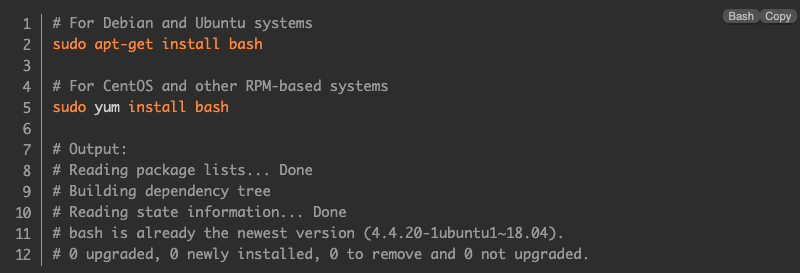
- On Linux: Most distributions come with Bash pre-installed. To check, open your terminal and type
bash --version. If not installed, use your package manager. - On macOS: Bash is pre-installed. Open Terminal and type
bash --versionto check the version. - On Windows: Install Windows Subsystem for Linux (WSL) and choose a Linux distribution from the Microsoft Store, which includes Bash. Alternatively, use Git Bash by installing Git for Windows.
Verifying Bash Installation
Use the following command to verify that Bash is installed and check its version:

Setting Up Your Environment
Before we start writing the Bash script to create our cross-distribution application installer, it’s important to ensure that our environment is configured correctly. This initial stage sets up the necessary structure for successfully installing the application on multiple platforms.
To Configure Your Bash Profile:
Edit your .bashrc or .bash_profile file to customize your environment. Common customizations include setting environment variables and aliases.
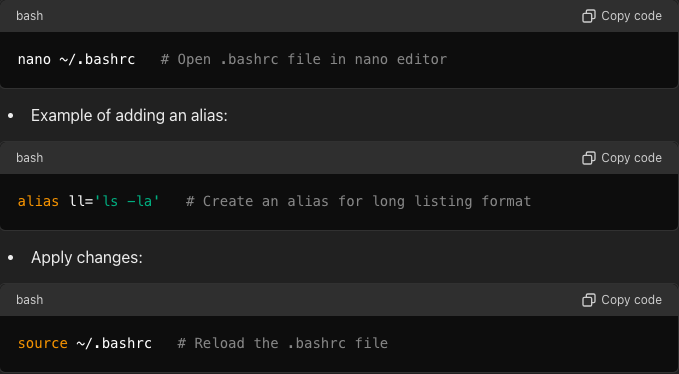
Common Bash Commands You Should Know
Here are a few Bash Scripting Commands you should get familiar with, it helps clear concepts beforehand.

First Bash Script: Hello World
This is just a brief idea for our readers who may be new to this concept about what is Hello World. One of the simplest programs you will learn is a text file known as a bash script comprises a series of codes or commands that may be typed into the terminal and executed. The first program we learn to write in every programming language is “Hello World.”
Here’s a quick guide on writing your First Bash Script on Hello World. Just follow the given steps and you’re good to go:
Step 1: Open your favourite, Terminal text editor and create a new file called hello_world.sh. Then navigate the desktop folder or directory using the cd command.
Step 2: Create an empty file as a shell script using, the touch command and name it bash_script.sh to execute. The dark highlighted line is the file you created, just an example for, yours might be different.

Step 3: Making the script executable: You can open it on any editor chmod +x hello_world.sh. chmod+x is used to make the file executable by changing its permissions.
nano hello_world.sh # Create and edit the script in the nano editor
Add this command to the file: #!/bin/bash echo “Hello, World!”
Step 4: Running the script: Now you can your script on ./hello_world.sh.
Here’s an example of the executed output.

Basic Bash Scripting Concepts
We began with the guide on getting started with Bash Installation, execution, and output, now Let’s dig deeper into the 3 most important Bash Scripting concepts you must know.
1. Variables
In Bash, we can use variables. Bash uses special characters to reference variables, ensuring they are properly referenced and replaced with their corresponding values.

Declaring a variable is simple: username=”Alice”. You can use a variable’s value by prefixing it with a dollar sign (echo $username). Name and Age are the two variables that have been defined here. You may access these variables with $Name and $Age.
In other words, we can use VariableName=Value to declare a variable in a bash script and $VariableName to access it.
Variables can hold text, integers, or the results of instructions, and the script allows for the modification of their values. For example, the number of files in a directory is stored in file_count=$(ls | wc -l).

Even though variables in Bash are loosely typed or untyped, there are some conventions and best practices to follow:
- Variable names should consist of letters, numbers, and underscores.
- They cannot start with a number.
- Avoid using special characters or reserved keywords to prevent conflicts.
Bash scripting typically doesn’t require exporting variables. However, to simplify tasks and ensure reusability, you may divide them into multiple scripts.
For instance, a script can copy filenames and add today’s date to them, allowing snapshots within other scripts.
If a variable, is declared inside a function then it is generally a local variable and if it is declared outside then it is a global variable. In the case of a bash script, this concept is a little bit different, here any variable whether it is written inside a function or outside a function by default is a global variable. If we want to make a local variable then we need to use the keyword “local”.
2. Functions
Functions are also used within Bash Scripting, let’s see how they work.
In programming, A function is a block of code that performs some tasks and it can be called multiple times for performing tasks.
Bash script functions contain reusable code parts. They are defined as follows: a name, a set of commands enclosed in braces, and parentheses.
A simple example of how the function is used:
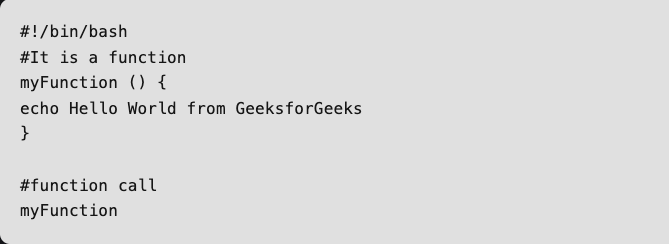
This function takes a parameter and prints a greeting. Functions promote code reusability and readability, making scripts more organized and maintainable.
Furthermore, a Function can also have arguments or parameters added to it so that data can be passed to it and used by the function to perform actions. The following syntax can be used in bash scripting to write a function that accepts arguments.
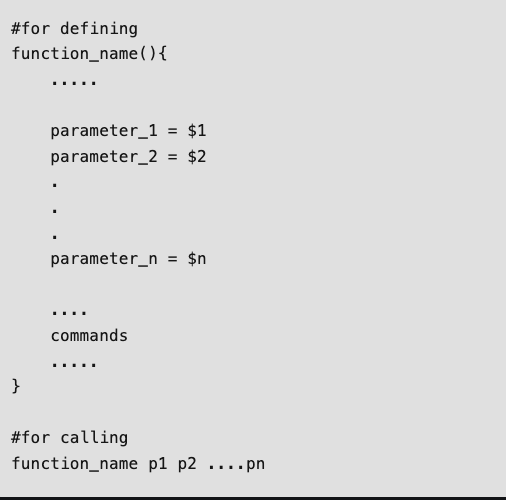
This should give you a clear and better idea about the use of Functions. Let’s discuss further Bash Scripting Key concepts.
3. Script Comments for Readability
Script Comments is another Key Bash scripting concept and you must be familiar with its Use.
A statement that instructs the shell what to perform is called a command. Simple or complex commands can be input into the terminal.
In Bash scripting, comments begin with a #. This tells the interpreter to ignore any line that starts with a # as a comment. Adding comments to the code is a great idea because they help with code documentation and make the code easier for others to understand.
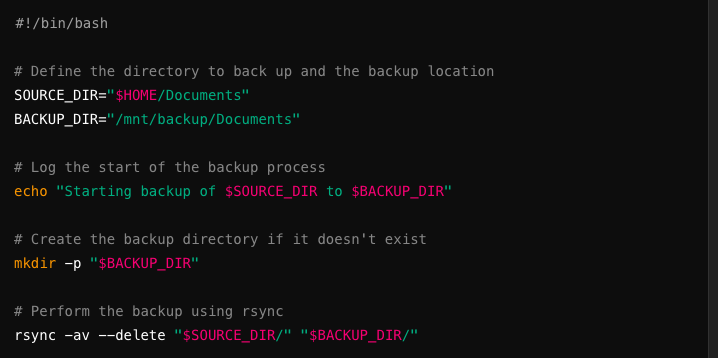
Major Errors in Bash Scripting
You can encounter the following Bash Scripting errors, The following will help you identify them in a second whenever you see it.
Syntax errors

Runtime errors occur during the execution of the script.

Logical errors are bugs in the script’s logic that lead to unexpected behavior.

Failing to validate user input or command-line arguments can lead to unexpected behavior.

Bash Scripting: Pros and Cons
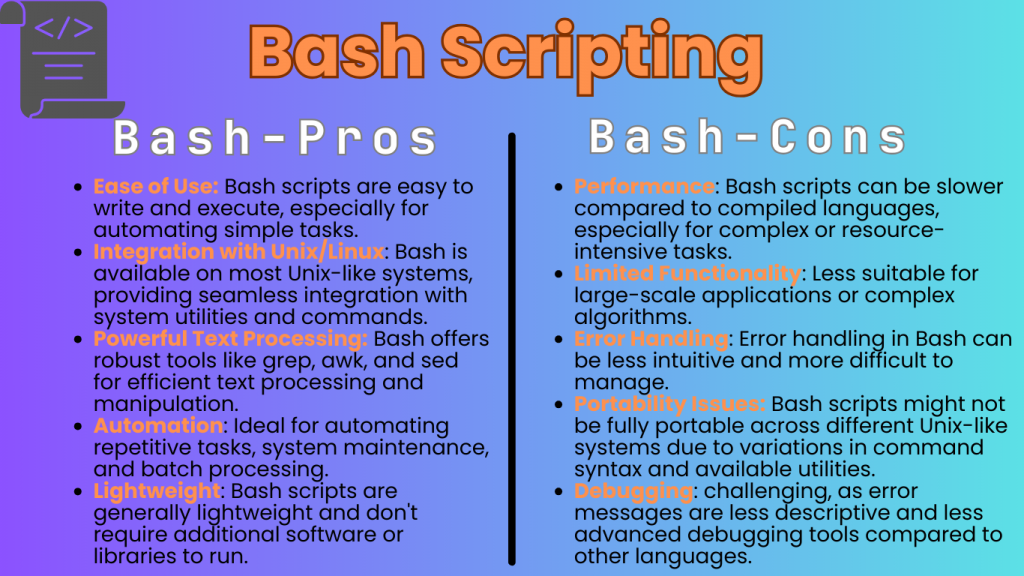
How to Troubleshoot Bash Scripting Issues?
To make sure your scripts are bug-free you must know the following solutions to fight any unexpected error or behavior.
- Enable Debugging Mode: Insert
set -xat the beginning of your script to enable debug mode. This will print each command and its arguments as they are executed. Disable withset +x: Useset +xto turn off debug mode. - Check the exit code Status:
$?Variable, Check the exit status of the last executed command using$?. An exit status0usually means success, while any other value indicates an error. - Use
echoStatements: Useechoto print the values of variables at different points in your script to ensure they hold expected values. - Error Messages: Use
set -eto make the script exit immediately if any command returns a non-zero exit status and redirects the error message to a file. - Use ShellCheck: This is a Static Analysis Tool, a very powerful tool for analyzing shell scripts to find syntax and semantic errors.
Final Thoughts
This article explains in great detail Bash scripting which is an essential tool for automating tasks within the Linux environment.
Now you know that Bash is a command-line interpreter that offers developers a simple and intuitive way to create scripts for streamlining everyday tasks, managing files, and executing complex operations.
Knowing how to write Bash scripts is a valuable skill in system administration and development. It automates boring tasks and efficiently executes commands, enhancing productivity in a rapidly evolving tech landscape.
However, using Bash scripting also involves dealing with troubleshooting issues and we provided you with solutions such as debugging, checking exit code status, and error messages, or using ShellCheck to implement decision-making processes, and manage permissions. Master Bash scripting, and leverage its capabilities to improve system administration on Linux platforms and boost their productivity.



